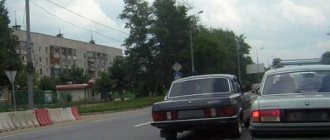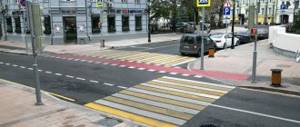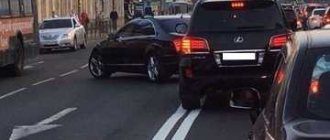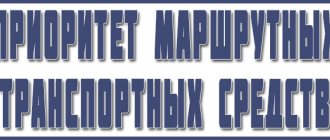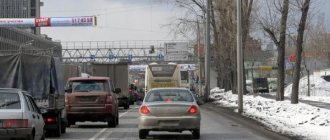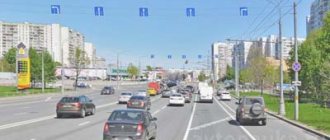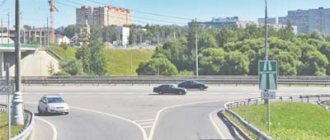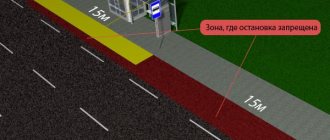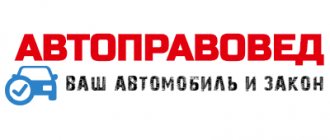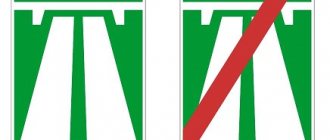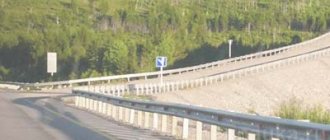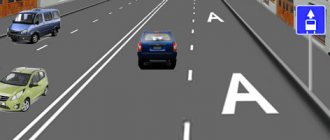Sign 5.11.1 “Road with a lane for route vehicles”
The sign “Road with a lane for route vehicles” is used to designate a road on which the movement of route vehicles, as well as other vehicles allowed to move along with route vehicles, is carried out along a specially designated lane towards the general flow of vehicles.
Sign 5.11.1 “Road with a lane for route vehicles” is installed at the beginning of the road section above the carriageway or on both sides of the road. Repeated sign 5.11.1 is installed after intersections with complex layouts.
You need to pay attention to the fact that the dedicated lane on the road marked with sign 5.11.1 is oncoming! Accordingly, sanctions for driving on it can be applied as for driving in the oncoming lane (fines for this violation are at the end of the article).
In what cases can you use a dedicated lane 2020
There are exceptions to all rules. This fully applies to dedicated lanes for public transport, the movement of personal cars along which is prohibited under normal conditions.
There are several "urban legends", "fictional facts" and exaggerations associated with the highlighted stripes. They arose due to differences in regional Codes of Administrative Offenses at the early stage of the introduction of bus lanes in the Russian Federation.
So, some motorists believe that it is possible to use dedicated lanes in case of traffic congestion, others suggest that driving into a “dedicated lane” is permissible if there is no interference with the movement of public transport. Still others claim that it is allowed to drive on “separate lanes” on weekends. All three of these statements are false!
List of conditions allowing motorists to use the dedicated lane:
- Information signs (For example, dedicated areas can function only on weekdays, or only during daylight hours)
- Article 2.7. "Urgent necessity." (You can drive into a dedicated lane in an attempt to avoid, for example, hitting a pedestrian.)
- Broken line (Near intersections or near road on-ramps and exits)
- Lack of markings or “dedicated lane” sign
- Unreadable markings or markings covered with snow/sand
- For boarding and disembarking passengers. (however, you must not interfere with public transport and cross a continuous road (you must look for a gap).
Signs 5.13.1, 5.13.2 “Exit onto a road with a lane for route vehicles”
Signs 5.13.1 and 5.13.2 “Exit onto a road with a lane for route vehicles” are used to indicate exits to the road marked with sign 5.11.1 and are installed in front of all side entrances.
Signs 5.13.1 and 5.13.2 indicate that there is a dedicated lane for route vehicles on the road being crossed. Accordingly, after sign 5.13.1, all vehicles that are not allowed to move on the dedicated lane are prohibited from turning left, and after sign 5.13.2 they are prohibited from turning right.
If at the point of exit to the road there are several signs on one support, signs 5.13.1, 5.13.2 are usually located above other signs, i.e. above all, but this does not always happen.
It is permissible not to install signs at exits from adjacent territories if it is possible to enter these territories only from a road with a lane for route vehicles.
When can taxi drivers use a dedicated lane?
The bus lane is also intended for the movement of passenger taxis (clause 18.2 of the traffic rules). However, this car must meet a number of requirements:
- The vehicle must be painted yellow, and so-called “checkered” marks must be applied to the sides.
- There should be a specialized counter in the cabin.
- A special lantern must be installed on the roof.
Only if all of the above conditions are simultaneously met, the driver of the car receives the right to move in a dedicated lane for public transport. In addition, additional requirements apply for Moscow. Namely, the car has license plates on a yellow background.
Thus, private cab drivers who have not properly equipped their vehicles are not allowed to drive in the bus lane. In case of violation, they are assessed a fine from 1,500 to 3,000 rubles.
Sign 5.14 “Lane for route vehicles”
Sign 5.14 “Lane for route vehicles” is used to designate the lane along which route vehicles move alongside the general flow of vehicles. This strip is called a “dedicated strip”.
The sign “Lane for route vehicles” is installed at the beginning of the lane above this lane (on top), and if it is the far right, it is allowed to install the sign to the right of the lane (on the side of the roadway).
Sign 5.14 is repeated at each intersection throughout the entire section of the road where the traffic of route vehicles is organized along this lane.
A fine will be imposed for vehicles entering the designated lane without permission (at the end of the article).
Driving in the OT lane on weekends
A number of bus lanes are not operational on weekends. They are marked with signs 5.14 and 8.5.1 (8.5.3). Other vehicles will be able to use them on weekends.
The following circumstances must be taken into account:
- No additional entry restrictions . If a “brick” is installed on the highway lane (sign 3.1.), then entering it is prohibited on any day.
- A solid marking line has been applied . It is allowed to move along a dedicated lane on weekends, but crossing a continuous lane is prohibited. The motorist will be fined for this offence.
- Postponement of holidays . If a working day is moved from another day to Saturday, then other vehicles are prohibited from using the specified lane. Conversely, movement is permitted if the day is an official non-working day.
Sign 5.14.2 “Lane for cyclists”
Sign 5.14.2 “Lane for cyclists” is used to designate a lane along which the movement of bicycles and mopeds is permitted. The movement of bicycles and mopeds is carried out in a direction similar to the general flow of vehicles.
The “Lane for Bicycles” sign is installed at the beginning of the lane above this lane (on top), or to the right of the lane (on the side of the roadway).
For driving into a lane marked with sign 5.14.2 “Lane for cyclists,” as well as for driving vehicles other than bicycles and mopeds in this lane, Article 12.15 Part 2 provides for a fine of 2,000 rubles as of the date of publication.
Fines for leaving the lane for route vehicles
Entering a dedicated lane (for route vehicles) in a prohibited case can occur both in the same direction and in the opposite direction. Sanctions for these violations will vary.
For leaving the allocated lane in the same direction - a fine of 1,500 rubles. (in Moscow or St. Petersburg - a fine of 3,000 rubles).
For entering a designated lane in the opposite direction while avoiding an obstacle, the fine is 1,000–1,500 rubles.
For entering the allocated lane in the oncoming direction for any reason other than avoiding an obstacle - a fine of 5,000 rubles. or deprivation of rights for up to six months. In case of repeated violation - deprivation of rights for 1 year or a fine of 5,000 rubles.
A complete list of road signs with special requirements with brief comments (explanations) on the website is posted in Appendix 1 of the Traffic Regulations.
Navigation through a series of articles<<Signs of special regulations 5.5 - 5.10Signs for lane directions >>
Lane for public transport: is it possible to drive on it and what is the fine for violation
Entering the lane for route vehicles is a violation. Many motorists rightly believe this, and compliance with this rule helps them avoid fines. However, in some places it is possible to drive on a dedicated lane for public transport, and in some situations the driver is even required to enter it. Let's understand the nuances of what is not allowed and what is possible, and remember what punishment is provided for violation.
How can I tell if there is a public transport lane in front of me?
Entering the lane designated in traffic regulations as a “lane for route vehicles” is in most cases prohibited for passenger cars, so you need to understand how to avoid getting into the “prohibited zone.” First of all, attention should be paid to sign 5.14, which is called “Lane for route vehicles.” It is important because it indicates a dedicated passing lane. The end of such a strip is indicated by the sign 5.14.1.
The next important pair of signs are 5.13.1 and 5.13.2, indicating the presence of a dedicated lane for public transport on the road, which you can enter at the intersection. Accordingly, motorists are prohibited from turning left or right into the dedicated lane.
Well, and a couple more signs indicating “dedicated space” - these are 5.11.1 and 5.12.1. They mark the beginning and end of the lane for oncoming public transport. You need to pay attention to these signs when planning maneuvers - for example, a U-turn, which will be prohibited.
Another distinctive feature of the dedicated lane is the horizontal marking 1.23.1, which is located along the length of the lane and helps drivers remember its presence. In this case, the lane for public transport can be separated from other lanes in the same direction by a continuous marking strip 1.1
Who can ride in the public transport lane?
Driving along the public transport lane is regulated by clause 18.2 of the traffic rules. According to it, you can drive in dedicated lanes
:
- route vehicles;
- school buses;
- passenger taxi;
- buses from a special list approved by the authorities of Moscow, St. Petersburg and Sevastopol;
- cyclists if such a lane is located on the right.
All other vehicles are prohibited from driving or stopping in the public transport lane
. That is, carsharing cars, private taxi drivers in unlicensed cars, motorcyclists, cyclists, and so on are not allowed to move along it. There have long been discussions among legislators about allowing certain other categories of drivers to drive on dedicated lanes - for example, owners of electric vehicles or those who practice carpooling (sharing a car when the owner gives rides to fellow travelers). However, for now, as of the beginning of 2021, all these initiatives remain just talk.
Moreover, you need to understand that even school buses and passenger taxis are not always allowed to use the public transport lane
. They can enter it only if there is no sign 3.1 “No Entry” (aka “brick”) at the entrance. In the material devoted to driving under prohibitory signs, we found out that the “brick” does not apply to route vehicles, but everyone else is prohibited from driving under it. Thus, sign 3.1, installed in addition to sign 5.14, makes it possible to designate lanes on which only public transport can travel.
What exceptions are there for ordinary motorists?
There is one important exception to the ban on driving on dedicated lanes : sometimes sign 5.14 can be supplemented with information signs 8.5.2 and 8.5.3
, which clarify that the public transport lane is only valid on weekdays or, for example, from Monday to Saturday. Thus, on weekends and other days, marked with an additional information sign, the lane is no longer allocated, and movement on it is allowed to everyone without exception, as in a regular lane. Sometimes this creates confusion - signs can appear and disappear, change, and so on, and besides, holidays are also considered days off, but only official ones. So before entering the public transport lane, you should make sure that this is allowed.
Another exception concerns entering a public transport lane to make a right turn. There is no direct indication of this maneuver in the traffic rules, but, as we remember, paragraph 8.5 of the traffic rules indicates that before turning right, left or making a U-turn, the driver must take the appropriate extreme position on the roadway in advance
designed to move in a given direction.
In a detailed article about driving in lanes and turns, we found out that you can only turn right from the far right to the far right lane. Thus, if in front of an intersection the markings separating the public transport lane change from solid to intermittent, you need to change lanes in advance to make a turn
. If the marking remains continuous until the intersection, you cannot change lanes into the designated lane, and turning right at such an intersection is prohibited.
What is the penalty for violation?
Entering the lane of public transport in the same direction is punishable under Article 12.17 of the Administrative Code. Part 1.1 indicates that the movement of vehicles in the lane for fixed-route vehicles or stopping in the specified lane is in violation of the Traffic Rules
<…> entails the imposition of an administrative
fine in the amount of 1,500 rubles
.
And part 1.2 specifies that the violation provided for in part 1.1 of this article, committed in Moscow or St. Petersburg
, entails an administrative
fine in the amount of 3,000 rubles
.
You can get another fine if you enter the public transport lane through a solid marking line. Such a violation is interpreted under Part 1 of Article 12.16 as failure to comply with the requirements prescribed by road signs or markings of the roadway, and entails a warning or
imposition of an administrative
fine in the amount of 500 rubles
.
The fines mentioned above are associated with driving into the lane of public transport in the same direction. If you enter the oncoming lane of public transport through a continuous marking line, then such a violation will be punishable according to the standards of entering oncoming traffic. That is, when driving around an obstacle through a solid road, the driver will receive a fine of 1,000 to 1,500 rubles, and when overtaking, a fine of 5,000 rubles or deprivation of rights for a period of 4 to 6 months. Repeated overtaking through a continuous road within a year entails deprivation of rights for a year if stopped by an inspector or a fine of 5,000 rubles if the violation is recorded by cameras.
Source
